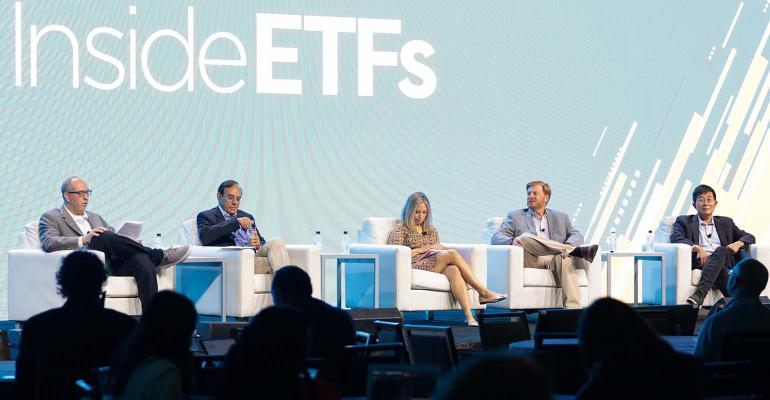There’s a clear secular shift in the ETF space playing out with greater growth in fund flows and launches on active vs. passive ETFs compared compared to historical trends. The tax and fee benefits ETFs provide relative to mutual funds are one driver. Another factor is that high correlations between stocks, bonds and other assets in the last two years have driven clients and investors to seek an asset that might provide diversification going forward. And a third is the promise of active ETFs to generate alpha returns for investors.
These were themes visited during two sessions at the Inside ETFs conference as part of Wealth Management EDGE at The Diplomat Beach Resort in Hollywood Beach, Fla.
Overall, 60% of all ETF issuance in the last two years has been with active products, and active ETFs now account for nearly $1 trillion in assets, according to figures cited at the conference. In addition, active ETFs accounted for 31% of net flows in the first quarter of 2023, despite only accounting for 5% of total ETF assets. That share of flows is more than double the 2022 figure of 14%, which, in turn, was the first year that active ETFs captured more than 10% of flows.
“When you want to get alpha, slowly but surely, mutual funds will do less and active ETFs will be more prevalent in the industry,” said Malik Sarwar, Senior Partner, Global Leader Group, during The Role of Active ETFs in Managing Volatility and Generating Alpha session at the conference. Other speakers there included Becky Lightman, founder and managing partner, Lightman Capital; Vince LoRusso, co-founder & portfolio manager, Changebridge Capital; and Scott Peng, CIO, Advocate Capital Management. All three firms are sponsors of active ETFs.
Lightman said much of the interest in the space is coming from RIAs rather than wealth management shops at banks, which have more conservative asset allocation strategies and may be waiting for active ETFs to build more of a track record.
“Since I entered (the RIA space), what I love is the creativity,” said Lightman. “We have a universe of options available to us and we can take the firm anywhere we want it to go. The double-edged sword of that is we almost don’t know how to evaluate all the options presented before us. As we look at the active ETF universe, RIAs are going to want to be more creative and get their alpha through active ETFs.”
Peng highlighted the need for an asset that’s not correlated to what might already be in clients’ portfolios. Up until 2020, bonds and equities had a low level of correlation, filling that need. But in recent years, that correlation has flipped and stocks and bonds have been far more in sync. This may not be a temporary blip, but a return to what was the norm in previous decades.
“In the 20 to 30 years prior to 2000, in most every year equities and bonds were positively correlated,” Peng said. “This may be a reversion to this old paradigm. … The kicker here really is that bonds have lost the diversification and risk mitigation role they had in portfolios. Advisors and investors need to look (at other assets).”
And that’s where active ETFs could slot in.
“Potentially, this is something that people should think about in this new world order,” Peng said.
A second session, Strategies and Solutions for Actively Managed ETFs, featuring Mark Juelis, SVP-Financial Intermediaries, Brandywine Global, a Franklin Templeton Specialist Investment Manager; Tim Coyne, global head of ETFs, T. Rowe Price; Philip McInnis, chief investment strategist, Avantis Investors; and moderated by Michael Gayed, portfolio manager, ETF Think Tank, continued on the same thread.
“We have seen this segment start to develop in real time,” Coyne said. “It’s setting up really well for the next five to 10 years to provide access to high quality strategies in a vehicle that meets investor needs.”
T. Rowe Price’s approach has been to take investment theses that have been successful in its mutual funds practice and move those into ETF wrappers. That’s a strategy that other mutual fund players have taken alongside the play of outright converting some mutual funds into ETFs.
“When I think about conversions, I think it’s a necessity” McInnis said. “The ETF is a much more tax efficient vehicle. And from the standpoint that you have different vehicle, you offer up a choice and let the client decide. … (But ultimately) if you have a taxable investor, the ETF makes more sense than the mutual fund.”
The rise in interest in active ETFs could grow further as newer ETFs build up track records. Some wealth managers are prevented from moving in before products have been in the market a certain time or met minimum AUM thresholds.
“There’s a lot of product that has come on and that’s still being worked through,” Coyne said. For T. Rowe Price, “The first year lot of our conversations were about the structure and a lot of clients stayed on the sideline. Now they’ve seen the products and how they behave on the trading market and how they’ve performed, and people are ready to come in.”




